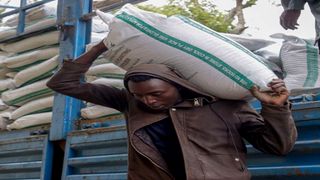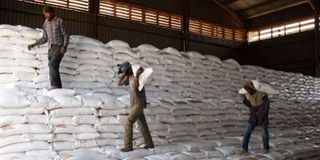
Workers offload bags of subsidised fertiliser from a lorry at the National Cereals and Produce Board depot in Elburgon, Nakuru County on August 5. Farmers say they are yet to access the commodity, which is supposed to be sold at Sh2,500 down from Sh3,500.
| John Njoroge | Nation Media GroupWeekly Review
Premium
Inside the fertiliser cartels: How subsidies enriched wealthy farmers in Rift Valley
What you need to know:
- Despite ITS broad coverage, distribution was skewed towards large farmers in the Rift Valley
- Fresh report from Egerton University shows that subsidies enriched wealthy farmers in two counties, instead of cushioning the poor in all parts of the country
What lesson has Kenya learnt and what has been the economic impact of the national fertiliser subsidy programme which the administration of President William Ruto launched after coming to power in August 2022?
Egerton University’s Tegemeo Institute of Agricultural Policy and Development – the independent and most foremost think-tank on agricultural policy issues – has just published a new study that will make policy makers rushing back to the drawing board. In theory, State subsidies are supposed to be tools of mercy, meant to cushion the poor in all parts of the country and making services more affordable to the disadvantaged.
But in Kenya, according to the findings of the study, fertiliser subsidies have only served sections of the country. Far from assisting the poor farmer, the subsidy programmes have mainly enriched the already empowered.
The study found that despite the programme’s broad coverage, the distribution was skewed towards large maize farmers in the Rift Valley.
About 79 per cent of the subsidised fertiliser distributed in the 2023 main season went to two counties, with Uasin Gishu and Trans Nzoia receiving 22 per cent and 17 per cent of the total subsidy in the same period.
The ramifications for private sector supply chains have been heavy. The study found that the implementation model weakened the private sector by crowding out their investments out of the fertiliser market.
While the programme made fertiliser affordable to farmers, it had the effect of excluding over 30,000 small and medium enterprises and agro dealers network that has its own well-developed last mile distribution coverage.
Yet, another noteworthy finding of the study was that – if you remove the subsidy element – the government and the private sector achieved roughly the same last-mile distribution costs. After factoring handling and distribution costs, the average landing price for a 50-Kg bag of the subsidised fertiliser was Sh5,405 for the government and between Sh5,352 and Sh5,597 for last-mile agro dealers.
The government mandated the Kenya National Trading Corporation (KNTC) to contract companies to supply fertiliser on the government’s behalf.

Farmers transport bags of subsidised fertiliser from the National Cereals and Produce Board depot in Elburgon, Nakuru County on August 2, 2023.
Contrary to past practice, where the government contracted importers through international competitive bidding, KNTC single-sourced the contracts.
The agency procured a total of 472, 500 metric tonnes of fertiliser, representing 80per cent of fertiliser imported in the year 2022. The two single-sourced suppliers were ETG, which supplied 242,500 metric tonnes and Yara East Africa Ltd that supplied 170,000 metric tonnes of assorted fertiliser.
In a departure from past practice, it was supplied to KNTC on a consignment basis – meaning that the government would only pay for the fertiliser that had been purchased by farmers.
The product was not to be purchased by the government outright. The study found out that not all quotas allocated to ETG and Yara were delivered.
In addition to the product that came from these two suppliers, KNTC directly imported 15,000 metric tonnes of NPK and another 30 MT of Fomi Kuzia fertiliser for Tanzania.
KNTC also contracted a company known as First Supplies Ltd to import 25,000 metric tonnes of CAN fertiliser. Under the arrangement, the suppliers imported, cleared, bagged and paid warehousing charges.
An additional Sh750 per 50kg bag was allocated for handling and distribution of the fertiliser in KNTC and National and Cereals and Produce Board stores. Thus, the average landing cost for subsidised fertiliser to either KTNC or NCPB stores in the long rain season of 2023 was Sh5,405 compared to the national average wholesale and retail prices of Sh5,318 and Sh5,591, respectively.

Workers arrange bags of Urea fertiliser after offloading them from train wagons at the National Cereals and Produce Board depot in Elburgon, Nakuru County, in late April.
The government registered 3,228,412 farmers through assistant chiefs. Overall, the State procured 472, 000 tons of fertiliser for the subsidy programme in 2023. About 210,000 were delivered to various NCPB stores, out of which farmers purchased 175,090.
Over 35,000 of subsidised fertiliser lie undistributed in different depots, mainly because it was distributed when the planting season had progressed.
About 261,000 tonnes of procured fertiliser is yet to be delivered. The total stock balances of subsidised fertiliser for the season of 2023 are about 297,000 tons. The estimated annual demand is about 800,000 tons, and consumption for the short season is about 30 per cent of annual demands.
Consequently, the available sensitised fertiliser stock exceeds the short term demands, in other words, the fertiliser market is saturated with subsidised fertiliser, and private fertiliser traders will not be in business in the short season of 2023.





